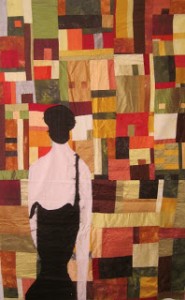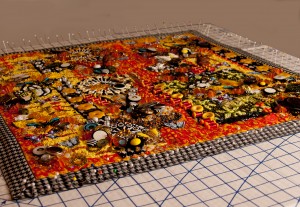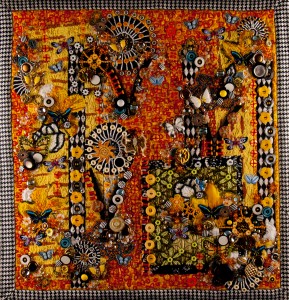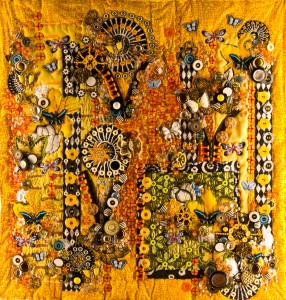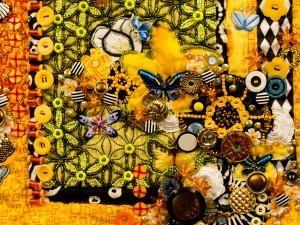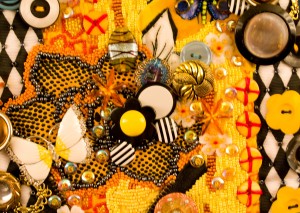Photos provided by the artist, Nina-Marie Sayre
When I put out a call recently for anyone who had photos of unfinished objects(UFOs), my new friend over the Internet, Nina-Marie Sayre was one of the first to send in photos and information. Her blog is well written and has a huge number of followers. On Friday’s she has a feature where you can post a blog that you’ve published the previous week, so my art quilting world is quickly expanding.
Her is a photo of the full view of “Shady Sadie”, one of Nina-Marie’s UFOs. She had quite a lots of comments on her own blog regarding suggestions from others as to how she could finish the piece. Many of the comments were about why the one extended arm was so long. Nina-Marie had started the piece at a quilt conference, and loves using women as subjects in her work. She’s “not above abstracting her (Sadie) either. I want the piece to have a little mystery and texture.” So there you are from the artist’s mouth; this woman is supposed to have a very long arm!
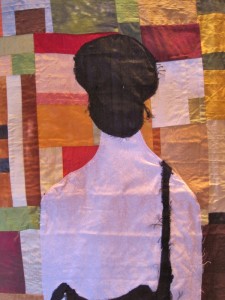 Here’s a close-up of Sadie’s back and head. One possibility that Nina-Marie proposed in an early correspondence with her was to tattoo Sadie’s back and add some embellishments. While I don’t personally have any tats, I’m all for embellishments of any kind, so that got my attention. An interesting tattoo could certainly add to the air of mystery that Nina-Marie said she was looking for.
Here’s a close-up of Sadie’s back and head. One possibility that Nina-Marie proposed in an early correspondence with her was to tattoo Sadie’s back and add some embellishments. While I don’t personally have any tats, I’m all for embellishments of any kind, so that got my attention. An interesting tattoo could certainly add to the air of mystery that Nina-Marie said she was looking for.
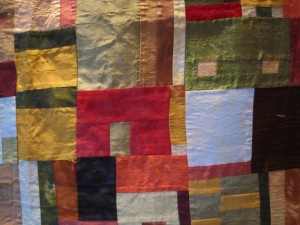 In this background photo, you can see some of the fun that Nina-Marie had in composing the blocks that make up the majority of the quilt. She used silk backed with a thin fusible material so that it wouldn’t ravel. I said that she was brave to use silk, and Nina-Marie said it wasn’t too hard to use with the backing. When asked about her use of that exotic material for quilting, she did say that she only uses a little, as it’s expensive and it (silk) “seems to have only one level of saturation – a lot!”
In this background photo, you can see some of the fun that Nina-Marie had in composing the blocks that make up the majority of the quilt. She used silk backed with a thin fusible material so that it wouldn’t ravel. I said that she was brave to use silk, and Nina-Marie said it wasn’t too hard to use with the backing. When asked about her use of that exotic material for quilting, she did say that she only uses a little, as it’s expensive and it (silk) “seems to have only one level of saturation – a lot!”
Nina-Marie had some great advice when I asked for her suggestions as to what to do with UFOs. “Don’t be afraid to cut it apart.” (I’ve done that one before.) “Don’t settle for just ‘OK’ .” (I try not to do that one.) However, one of her final nuggets of advice was “Don’t be afraid to give away a UFO that you don’t have any intention of finishing.” O-O-Oh! I need to work on this one, as I could use some room in my studio.
I’ve asked this before, but will ask again… how do you handle your UFOs? Also, I’m always looking for well-lit photos and information on your UFOs, so send them to me at info@fiberfantasies.com I’d love to feature you in an upcoming blog.
Why not leave a comment as to your thoughts on this posting. Please take a minute, fill out the form below or by clicking on the “comments/no comments link” at the top of the posting, and then share your ideas with the rest of us. We all grow when we share our thoughts and impressions, so why not join our growing community of those who appreciate art quilts and textile arts. We’d love to hear from you!… and PLEASE tell like minded souls about this blog! The more readers and contributors, the more I write because encouragement helps the words flow!
You can see more of my art work on my web site at www.fiberfantasies.com (be patient as it loads; it’s worth it), my spiritual healing work at www.transitionportals.com and can find me on Google + , Facebook (for Transition Portals) Facebook (for Fiber Fantasies), and Twitter.
To find out how to buy my art work, please check out “How to Buy my Art Work” in the “Pages” section to the right of this blog.

